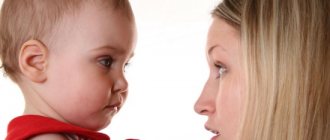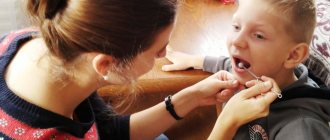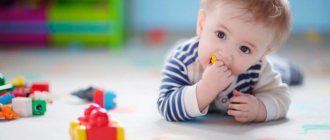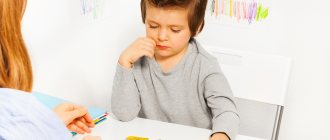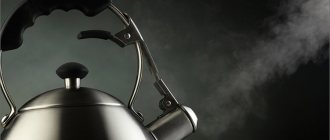What is massage for speech development?
How will it help improve a child's speech?
What types of speech massage can you do at home yourself, and which ones should you entrust to a specialist?
We will answer these and other questions in this article.
- Passive massage techniques
- Forehead massage
Who provides speech therapy massage for mental disorders?
All procedures differ in methods of implementation and areas of influence. As for speech therapy massage, its main task is to develop articulatory muscles and improve the condition of nerves. In this way, massage is performed exclusively in the area of the oral cavity and tongue. It is often prescribed to children aged 4-5 years when diagnosed with RRD. Usually combined with other types of massage and articulation exercises.
Who performs speech therapy massage for mental retardation:
- In order to perform speech massage, you must use a probe or fingers. Usually carried out by a speech therapist or parents. Please note that nails must be trimmed and there must be no jewelry on the hands.
- Most often this manipulation is carried out with gloves. It is worth noting that any massage for ZRR is prescribed exclusively by a neurologist. After examining the child, the doctor may write a referral to a speech therapist.
At the doctor
Providing services in our clinic
Before starting the massage procedure itself, the child is examined to determine indications/contraindications and determine the intensity, number of sessions and procedure technique.
The service provision process includes several stages:
- Introduction and history taking. A survey of parents is conducted about the child’s lifestyle, his hobbies and the intensity of systematic stress. The teenager's own complaints are listened to.
- Inspection. The doctor visually and palpably determines the presence of problems: curvature of the spine, salt deposits in the cervical-collar area, the state of muscle tone.
- Diagnostics. Based on the results of the survey, examination and tests obtained, an accurate diagnosis is made. If necessary, additional examination is prescribed (to exclude contraindications to the procedure).
- Prescription of treatment. After identifying the causes of the pathology, making a correct diagnosis and excluding diseases that are the main contraindications to massage, appropriate therapy is recommended: duration of the procedure, number of sessions, intensity of exposure and technique.
- Massage. The procedure for schoolchildren lasts from 15 minutes. The treatment and prophylactic course ranges from 10 to 20 sessions. A repeat cycle is usually carried out after six months (in order to consolidate the results obtained).
How is palm massage performed to develop baby's speech?
Palm massage is quite effective in dealing with RRR. Usually it is carried out independently by parents or children. It can be divided into active and passive. Passive is performed by parents or a doctor; as a result of the massage, areas on the palms and fingers of children are worked out. Both the outer and inner parts of the palm, as well as the area up to the elbow, are massaged. Just 15 minutes is enough to stretch these areas. In order for the child to calmly perceive the massage, it is carried out in a playful way, supplemented with poems and nursery rhymes.
While the child is small, parents perform this massage on their own. As soon as the baby masters the technique of performing such a massage, he can do it on his own.
Palm massage for baby speech development:
- It is necessary to stroke the child’s hands from the outside and inside. To do this, the touch should be very light, and sort of ticklish. Parents tickle the child's palm.
- White-sided magpie. This is a well-known nursery rhyme, during which a finger makes spiral movements in the area of the inner side of the palm.
- Blizzard. It is necessary to stroke your hands in a zigzag manner. At the same time, recite a poem about a blizzard.
- Snail. During this exercise, the palms are not just stroked, but thoroughly massaged and pinched.
Active points
Advantages of visiting the A-Media clinic
Massage of the cervical region for school-age children is the best way to combat fatigue and prevent spinal diseases.
We employ only highly qualified doctors with significant practical experience in this field.
Our specialists perfectly know and master all the techniques and massage techniques and can find an “approach” to any child, even the most intractable and “closed”, as well as to his parents.
If your child begins to often complain of fatigue, malaise, has problems with perseverance, or has decreased performance at school, then maybe you need to contact a manual specialist? Make an appointment at our clinic - together we will correct the situation and return your child to an active life!
How is facial massage performed for ZRR?
When performing the procedure, the doctor acts on the child’s forehead, cheeks, and chin. Typically, stroking, vibration, rubbing and even tapping are performed in this area.
How is facial massage performed for ZRR:
- In order to perform a forehead massage, it is necessary to carry it out along the massage lines. To do this, you need to move your fingertips, with a very light touch, with both palms from the middle of the forehead to the temporal part. The exercise is performed with both hands at once. Next, you need to massage your forehead from the eyebrows to the top of the forehead. The result is a zigzag movement.
- When performing a cheek massage, you need to rub along the lines, from the corners of the lips to the temples. As in the first case, it is necessary to carry out movements with both hands at once. Next, you need to perform stroking movements from the temple, touching the cheekbone area, and towards the lower jaw, going down to the collarbone area.
- Rub the upper lip from the middle to the corners of the mouth. Movements should be circular or zigzag. Carry out exactly the same exercises with the lower lip.
- The chin is often massaged using circular movements in a spiral direction from the chin to the corners of the mouth.
Satisfied child
How is massage of the collar area performed for cervical cancer?
For RRR, massage of the neck, shoulder blades, and collarbones is quite effective. He prescribes not only for stimulation, but also for general improvement of the body’s condition. The fact is that a common cause of RRD is birth trauma, as well as pinched nerves in the neck. This allows you to improve blood circulation in the brain area, thereby stimulating the development of the speech apparatus. During the massage, all muscles, as well as the brain, are saturated with oxygen. This occurs due to stimulation of the area responsible for speech.
How is massage of the collar area performed for cervical cancer:
- Usually the massage session is not very long, only 20 minutes. Please note that it is performed without pain or strong pressure. Consists of approximately 20 sessions. Recommends repeating after 2 months. When performing a massage, the child is laid on his stomach, with his arms along the body. The massage begins with light stroking, movements from top to bottom, in the neck area.
- After this, you can increase the pressure and perform rubbing movements in this area, but with three phalanges of your fingers. After this, a massage is performed on the muscle that is located between the neck and shoulders. It is necessary to work not only the neck, but also the upper back.
- It is worth noting that speech therapy and speech massage is quite useful, but in order for it to give a good result, it should be combined with breathing and voice exercises.
The principle of choosing methods of physiotherapy for delayed speech development
Delayed speech development is not always associated only with problems of the speech apparatus, often these are manifestations of disorders with vision, hearing, nervous system , these can be the consequences of negative influences during intrauterine development, as well as if a natal injury has been diagnosed. Physiotherapy is prescribed for delayed speech development if in early childhood the child suffered injuries or certain viral diseases , infections, and such factors provoked a complication.
What kind of massage can be used for cerebral palsy in children 3 years old?
For children aged 3 years, massage of the collar area is usually used, less often articulation gymnastics. At this age, the most important thing is to develop fine motor skills of the hands, influencing the centers located on the palms and hands.
What kind of massage can be used for cerebral palsy in children 3 years old:
- Therefore, the best option is to purchase prickly balls, small clothespins, and cereals. Let your child sort through the cereal and play with it more often. It is necessary that the active points on the child’s fingers are constantly activated. This stimulates brain development, thereby improving the child's speech.
- Remember, neck massage is most effective at the age of 3 years. It improves blood circulation in the brain, thereby improving the overall well-being of the child.
- It is best to perform a massage only after consultation with a doctor and demonstration of the exercises by an experienced massage therapist. The fact is that if you press hard enough, you can harm the child.
Massage with a probe
How is speech therapy tongue massage performed at home?
Speech therapy massage of the tongue is very effective in the fight against mental retardation. It can be carried out either with a special probe or with a toothbrush. This is done using gloves, lint-free wipes, and a clean toothbrush with silicone bristles.
How to perform speech therapy tongue massage at home:
- Initially, the tongue is stroked lengthwise, then from the center to the right and left. It is performed with short breaks, as the tip of the tongue is held all the time, which leads to constant drooling and discomfort in the child.
- Gentle stroking should be done without strong pressure, as the bristles of the brush can be quite hard and unpleasant. Under no circumstances should you cause pain to a child.
- During the massage, patting and tapping movements are often performed. For these purposes, it is best to use a toothbrush with silicone bristles, rather than a standard one made of nylon.
- This helps make the massage palpable and influence the points that are on the tongue. This allows you to stimulate the muscles of the tongue, improve its functioning, which helps in reproducing some hissing sounds that are difficult for a child.
Tongue massaging scheme
The need for physical activity and massage for children with delayed psycho-speech development or ASD
The need for physical activity and massage for children with delayed psycho-speech development or ASD. Reduced sensory sensitivity.
Children with reduced sensitivity in response to sensory stimuli sometimes demonstrate a passive response. They seem to ignore the stimulation because they do not respond to it. When exposed to stimuli that other people would normally respond to, they do not pay attention. For example, when you call a child by name, he does not seem to notice that he is being addressed. You can call your child's name several times in a row, but he doesn't seem to hear anything. You have to say your child's name loudly several times or stand right in front of him, otherwise he won't understand that you are talking to him. Another symptom of decreased sensory sensitivity is that the child is “loud”, active, constantly in motion, which is called “an awl in the butt.” With his behavior, such a child constantly demands attention from parents and other children, tries to get some form of physical contact from you - he comes to hug, loves to be massaged, loves strong physical stimulation in the form of running, jumping, wrapping himself in a blanket. At the playground, he tries to play on all the available children's equipment: slide, ladder, rings, ropes, logs. You may have noticed your child's decreased response to pain. Such children rarely cry from a fall, or their distress is unusual and extremely short-lived. Or another example of decreased sensory sensitivity is fearlessness. A child may behave carelessly with sharp objects, put his hands under very hot water, it is difficult to explain to him that failure to comply with pedestrian traffic rules can lead to a tragedy at a pedestrian crossing, etc. The classic symptom of low sensory sensitivity is hyposensitivity to touch and seeking stimulation through deep pressure. This is often due to poor awareness of one’s body, rapid fatigue, and incorrect application of force during movements.
How can you help your child get their sensory area in order?
How can we help them develop faster and better? Children with decreased sensory sensitivity (DS) need sprint activities that can quickly activate their sensory systems. A variety of music, rapid swinging on a swing, and active physical exercise increase the level of response to stimuli. Do your best to involve your child in movement activities, even if he prefers to sit and play on the computer. For example, you can buy your child gaming consoles that require you to play while standing and imitate movements. If your child has no dietary restrictions or allergies, try serving hotter, crunchier foods with strong flavors (garlic/onion) to increase sensory stimulation. Try to discover experimentally what exactly motivates him, and give him the opportunity to work for rewards.
Playful physical stimulation and massage.
Massage should be a mandatory accompaniment of your daily communication with your child.
Massaging the child’s body should take place in an unobtrusive, friendly manner and can be a pleasant addition to the evening for the whole family gathered around the TV. A massage to improve skin and muscle tone is carried out with warm hands, vigorously rubbing and then kneading movements along the muscle fibers:
1) From the toes along the foot - shin - without touching the kneecap, up the thighs in front and behind
2) From the lumbosacral region along the spinal column (without touching the bones of the spine) - lightly kneading the back of the neck - lightly stroking the scalp.
The response to the massage is a slight reddening of the skin.
Since each child is unique and sensory impairment can range from mild to severe, you may notice that the child's skin does not respond with redness to your hand movements, and the child himself lets you know that tactile touch is too weak for him. him. In this case, increase either the massage time or the strength of the impact. But in any of these cases, you need to focus ONLY ON THE CHILD’S WELL-BEING.
Games and play equipment for the home:
It is important to note that by having sensory-motor stimulation equipment in your home, you make it much easier for your child to receive sensory stimulation on his own.
Examples of such equipment:
1. An inflatable ball (fitball) with a diameter of 45 to 65 cm. Used to train the vestibular apparatus, develop coordination and agility, train the body to work with space and an unstable platform, and strengthen the muscle corset.
2. Swedish wall. Rope-ladder. Rings. Mesh hammock. Mini trampoline.
3. "Dry pool." An ordinary inflatable pool, small in diameter, filled with small plastic balls.
4. Ready-made production modules for children’s “tunnels”, “houses”, “tents”.
5. Bean bag chair. The special lump or ball filler of such bags gently stimulates skin receptors, and a comfortable position in the chair allows the child (and even an adult) to rest, relax, and calm the nervous system.
5. Various small devices for self-massage: “spiky” balls (it is better to take hard ones), an expander for developing hand strength, bolsters and rollers for massage, massage mats with “pebbles” or flat buttons without sharp edges glued to a dense base.
Always remember that the basis for your child’s well-being, health and development is your awareness of ways to help your child, an active parental position and support. We wish you success!
Massage of the cervical-collar area for RRR: reviews
It is necessary that a child associate massage not with something painful, but with pleasant manipulations. There are a lot of techniques that will be perceived by a child not as treatment and procedures, but as entertainment and games.
Massage of the cervical-collar area for RRR, reviews:
Natalia. I massaged my son, he is 5 years old. I'm going to school soon, but I have problems with speech. The neurologist prescribed this massage. The son did not go to the doctor’s office, he was constantly hysterical. I made courses at home. After 2 courses there were improvements.
Faith. My daughter had serious problems with speech. The main reason is birth trauma in the cervical spine. A friend recommended a neck massage. They hired a masseuse who came home. The effect is noticeable, but in addition to massage, we did articulation gymnastics.
Elizabeth. I love my son, I invest a lot of money and time in him. He started talking very late, so at the age of 6 he has problems with speech. We constantly massage the neck, upper back, and face. We go to a speech therapist, and my speech is gradually improving.
Facial massage
Many useful articles for the development of children can be found on our website:
- Pure sayings for children: the best selection
- Children's games from 6 years old for the development of hearing and perception
- Educational games for children from 5 years old
- Educational games for children from 1 year old
- Sayings and proverbs for preschool children
You can safely combine massage with poems and nursery rhymes. You can tell a popular fable, for example, “The bears were riding,” and massage the baby’s collar area. Try to also work on each spine in the cervical region.
Why do speech therapists prescribe massage?
Speech therapy massage is a special method for correcting articulation with effects on certain areas of the body (face, forehead, cheeks, nose, mouth, chin, collar area, cervical vertebrae, supraclavicular fossa, upper muscles of the shoulder girdle).
Teachers, speech therapists and defectologists assure that exercises with proper influence:
- normalize the work of sedentary muscles;
- increase the amplitude of articulatory movements, making them voluntary;
- correct the condition of muscle paralysis, cuts, convulsions, hyperkinesis;
- improve vascular function and muscle fiber elasticity;
- have a beneficial effect on the nervous and muscular system;
- eliminate deviations in the formation of sounds;
- stimulate kinetic movements;
- increase the strength and duration of exhalation;
- normalize fine motor skills and articulatory apparatus;
- reduce the manifestations of dysarthria and stuttering.
Reference!
It is important to correct speech defects in a child in a timely manner, otherwise in the future they will become an obstacle to development and maturation. Massage should be performed by a trained specialist, especially for babies under 1 year of age. Although some techniques can be learned by parents on their own in order to carry them out at home in a comfortable environment.


